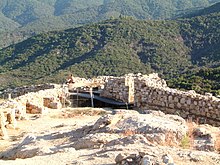Stagira (ancient city)
 Remains of the town wall of Stagira | |
| Alternative name | Stageira |
|---|---|
| Location | Olimpiada, Central Macedonia, Greece |
| Coordinates | 40°35′30″N 23°47′41″E / 40.59167°N 23.79472°E |
| Type | Settlement |
| History | |
| Builder | Ionian settlers from Andros |
| Founded | 655 BC |
| Associated with | Aristotle |
| Site notes | |
| Condition | Ruined |
| Ownership | Public |
| Management | 16th Ephorate of Prehistoric and Classical Antiquities |
| Public access | Yes |
| Website | Hellenic Ministry of Culture and Tourism |
Stagira (/stəˈdʒaɪrə/), Stagirus (/-rəs/), or Stageira (Greek: Στάγειρα or Στάγειρος) was an ancient Greek city located near the eastern coast of the peninsula of Chalkidice, which is now part of the Greek province of Central Macedonia. It is chiefly known for being the birthplace of Aristotle, the Greek philosopher and polymath, student of Plato, and teacher of Alexander the Great. The ruins of the city lie approximately 18 kilometres (11 mi) northeast of the present-day village of Stagira, and adjacent to the town of Olympiada.
History
[edit]Stagira was founded in 655 BC by Ionian settlers from Andros.[1] Xerxes I of Persia occupied it in 480 BC. The city later joined the Delian League, led by Athens, but left in 424 BC: as a result, the Athenian demagogue Cleon laid siege to it in 422 BC. However, Cleon was a poor strategist and his conduct of the siege was very inefficient: so much so that the ancient Greek comedy writer Aristophanes satirised him in the play The Knights.[2] Cleon died in the same year, in the battle of Amphipolis. Later, during the Peloponnesian War, Stagira sided with Sparta against the Athenians.[1]
In 348 BC, Philip II of Macedon occupied and destroyed the city.[1] In return for Aristotle's tutoring of his son Alexander, Philip later rebuilt the city and resettled the old city's inhabitants.[3] Many new structures were built at this time, including an aqueduct, two shrines to Demeter, and many houses.
Tradition has it that the natives of Stageira transferred Aristotle's relics to the city, buried it there, and founded a festival in his honour which was called "Aristoteleia".[1]
Much later, the Danish archaeologist Karl Frederik Kinch made several explorations of Chalkidiki in 1886, and he identified the site of Stagira based on ancient descriptions of it.[4]
Notable people
[edit]- Aristotle, philosopher
- Hipparchus (Ἵππαρχος), philosopher, acquaintance and kin of Aristotle[5]
- Nicomachus, father of Aristotle and doctor
- Arimneste, sister of Aristotle
- Nicomachus, son of Aristotle and philosopher
- Herpyllis, second wife of Aristotle and the mother of Nicomachus
- Nicanor of Stageira
See also
[edit]References
[edit]- ^ a b c d "Ancient stageira Halkidiki Greece". Travel-to-halkidiki.com. Retrieved 18 July 2017.
- ^ "The Internet Classics Archive | The Knights by Aristophanes". Classics.mit.edu. Retrieved 18 July 2017.
- ^ "Municipality of Aristotle – Travel Guide" (PDF). Aristotelis Municipality. 2011. Archived (PDF) from the original on 4 April 2023.
- ^ Bro, Thyge C.; Westergård-Nielsen, Nanna (25 February 2024). Makedonien – Europas første stormagt [Macedonia: Europe's first great power] (in Danish). Aarhus University Press. pp. 227–229. ISBN 9788771847451. OCLC 1328220687.
- ^ Suda, iota.520
Further reading
[edit]- Daniel Vainstub, "A Phoenician Votive Inscription on a Figurine from Stageira and the Root ṬNʾ", in A. Lemaire (ed.), Phéniciens d'Orient et d'Occident. Mélanges Josette Elayi, Cahiers de l'Institut du Proche-Orient Ancien du Collège de France 2, Paris, 2014, pp. 345–350

